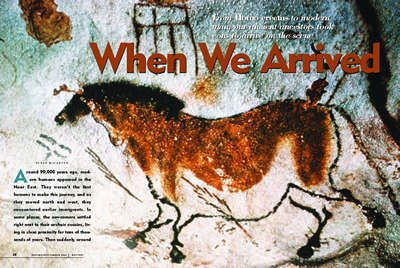 18 Oct 2001 @ 09:46, by sindy 18 Oct 2001 @ 09:46, by sindy
Around 90,000 years ago, modern humans appeared in the Near East. They weren't the first humans to make this journey, and as they moved north and west, they encountered earlier immigrants. In some places, the newcomers settled right next to their archaic cousins, living in close proximity for tens of thousands of years. Then suddenly, around 30,000 years ago, the older humans disappeared.
This brief summary seems straightforward, but almost every phrase is contested by one group of paleoanthropologists or another. Despite more than a hundred years of research, there's no agreement about why our Paleolithic ancestors left Africa, where they went, or even who they were.*
Archaeologists routinely draw conclusions based on fragmentary material. The further back in time you go, the more incomplete the evidence becomes. Archaeologists studying very early humans typically work with no more than a few broken bones and some stone tools. As a result, almost everything we say about our earliest ancestors is highly speculative.
The various names of the first human beings—for example, Homo erectus (upright person) and Homo habilis (handy person)—are based on a scientific system of classification called taxonomy. In a series of volumes entitled Systema Naturae, the Swedish taxonomist Carl Linnaeus (1701-1778) placed us firmly in the animal kingdom, along with other creatures that move, digest and breathe. Modern scientists continue to classify us with other animals through our order, Primates, a category that includes apes and monkeys. In the final four categories of increasing specificity—family (Hominidae), genus (Homo), species (sapiens) and subspecies (sapiens)—we are alone. It's hard to imagine that once there were other members of our family, genus and species, but there were. Scientists use a general term, "hominid" (members of the family Hominidae), to refer to all of them.
The first hominids evolved in Africa. By about 3 million years ago a variety of them were living in the East African savanna. In the currently accepted taxonomical scheme, they fall into two genera: Australopithecus (southern ape-like hominid) and Homo (the earliest human).
**In archaeological terminology, an industry is a group of related artifacts, such as stone tools, that were made at about the same time using the same manufacturing techniques. Artifact industries are generally named for the site at which they were first identified. For example, the Oldowan industry was named for Olduvai Gorge in Kenya, where Oldowan tools were first identified.
READ MORE:
[link]
|
|
 18 Oct 2001 @ 09:46, by sindy
18 Oct 2001 @ 09:46, by sindy